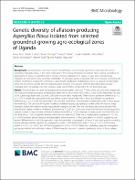| dc.description.abstract | Groundnut pre- and post-harvest contamination is commonly caused by fungi from the Genus
Aspergillus. Aspergillus flavus is the most important of these fungi. It belongs to section Flavi; a group consisting of
aflatoxigenic (A. flavus, A. parasiticus and A. nomius) and non-aflatoxigenic (A. oryzae, A. sojae and A. tamarii) fungi.
Aflatoxins are food-borne toxic secondary metabolites of Aspergillus species associated with severe hepatic carcinoma and
children stuntedness. Despite the well-known public health significance of aflatoxicosis, there is a paucity of information
about the prevalence, genetic diversity and population structure of A. flavus in different groundnut growing agroecological zones of Uganda. This cross-sectional study was therefore conducted to fill this knowledge gap.
Results: The overall pre- and post-harvest groundnut contamination rates with A. flavus were 30.0 and 39.2% respectively.
Pre- and post-harvest groundnut contamination rates with A. flavus across AEZs were; 2.5 and 50.0%; (West Nile), 55.0 and
35.0% (Lake Kyoga Basin) and 32.5 and 32.5% (Lake Victoria Basin) respectively. There was no significant difference (χ
2 = 2,
p = 0.157) in overall pre- and post-harvest groundnut contamination rates with A. flavus and similarly no significant
difference (χ
2 = 6, p = 0.199) was observed in the pre- and post-harvest contamination of groundnut with A. flavus across
the three AEZs. The LKB had the highest incidence of aflatoxin-producing Aspergillus isolates while WN had no single
Aspergillus isolate with aflatoxin-producing potential. Aspergillus isolates from the pre-harvest groundnut samples had
insignificantly higher incidence of aflatoxin production (χ
2 = 2.667, p = 0.264) than those from the post-harvest groundnut
samples. Overall, A. flavus isolates exhibited moderate level (92%, p = 0.02) of genetic diversity across the three AEZs and
low level (8%, p = 0.05) of genetic diversity within the individual AEZs. There was a weak positive correlation (r = 0.1241,
p = 0.045) between genetic distance and geographic distance among A. flavus populations in the LKB, suggesting that
genetic differentiation in the LKB population might be associated to geographic distance. A very weak positive correlation
existed between genetic variation and geographic location in the entire study area (r = 0.01, p = 0.471), LVB farming
system (r = 0.0141, p = 0.412) and WN farming system (r = 0.02, p = 0.478). Hierarchical clustering using the unweighted
pair group method with arithmetic means (UPGMA) revealed two main clusters of genetically similar A. flavus isolates.
Conclusions: These findings provide evidence that genetic differentiation in A. flavus populations is independent of
geographic distance. This information can be valuable in the development of a suitable biocontrol management strategy
of aflatoxin-producing A. flavus. | en_US |


